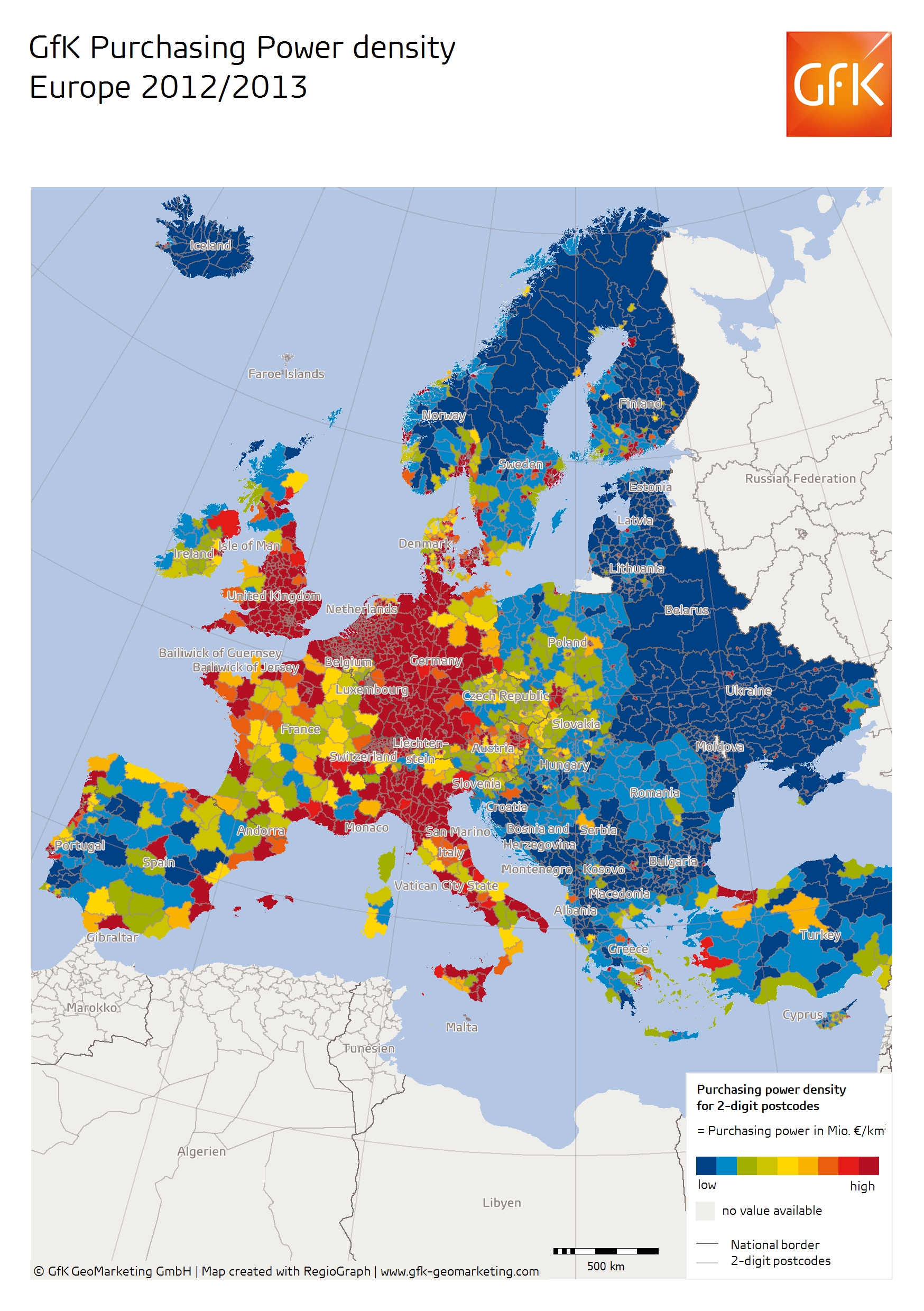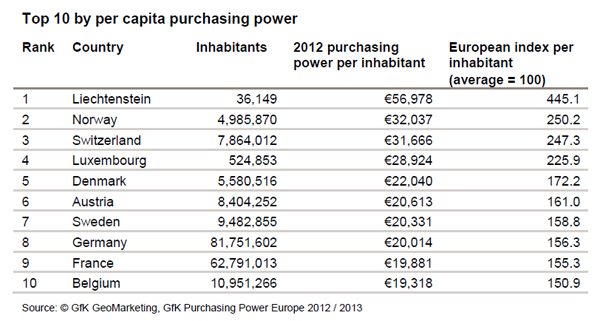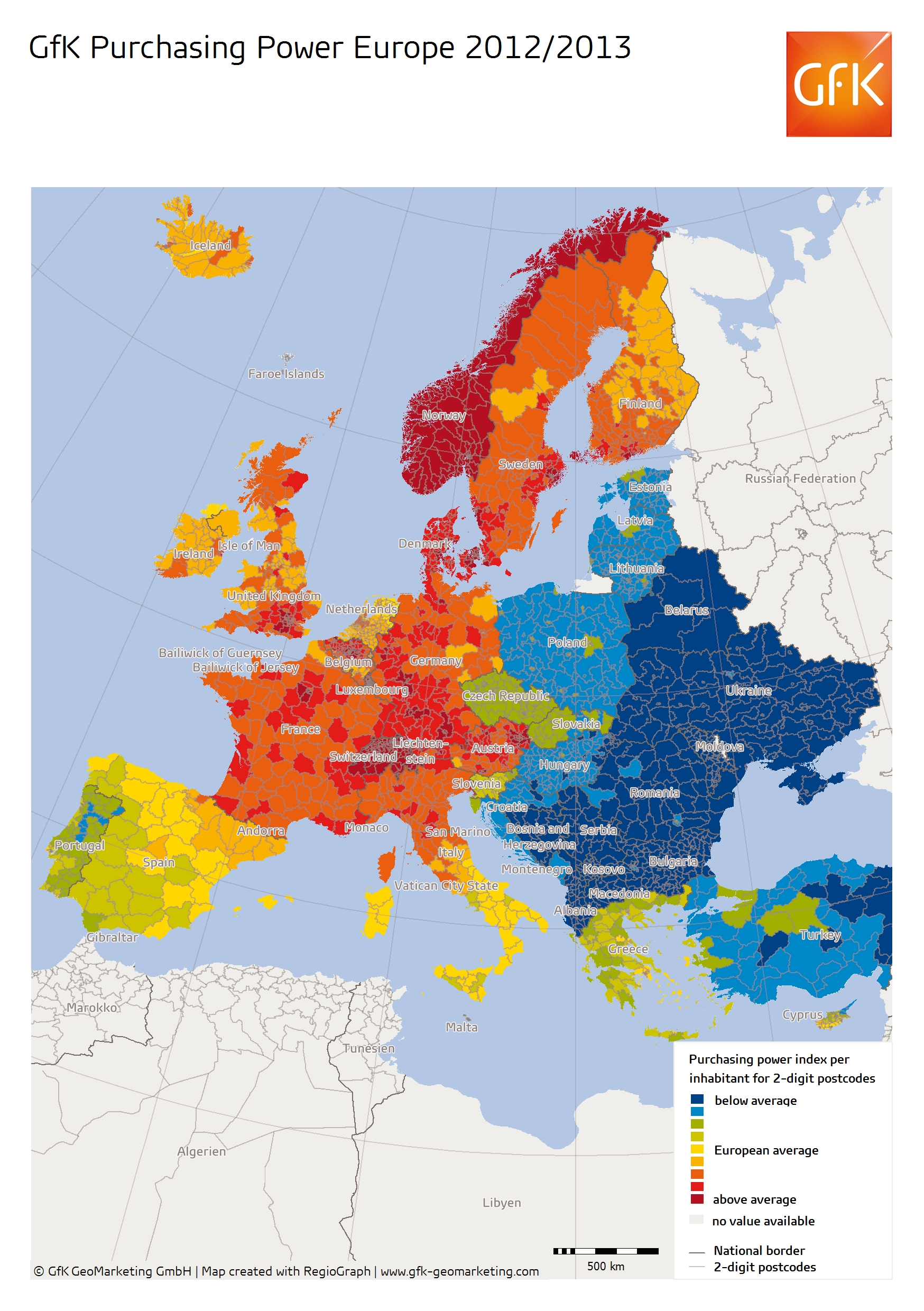|
 Nuremberg, 30 October 2012 – The latest GfK Purchasing Power Europe study for 2012/2013 analyzes regional differences in consumers’ purchasing power across 42 European countries. At country level, purchasing power ranges from 4.5 times the European average in Liechtenstein to one tenth of this average in Moldova. Spain approximately reflects the average per capita purchasing power in Europe. Nuremberg, 30 October 2012 – The latest GfK Purchasing Power Europe study for 2012/2013 analyzes regional differences in consumers’ purchasing power across 42 European countries. At country level, purchasing power ranges from 4.5 times the European average in Liechtenstein to one tenth of this average in Moldova. Spain approximately reflects the average per capita purchasing power in Europe.
According to GfK’s study on purchasing power, European consumers have approximately a total of €8.6 trillion at their disposal to cover their total spending and savings in 2012. This corresponds to an average purchasing power of €12,802 per inhabitant across the 42 countries the study covers. Per capita growth amounts to 2.1 percent.
In the 42 countries, differences in the trend in wages and salaries as well as inflation mean that the amount of disposable income varies. GfK’s purchasing power study examines the nominal purchasing power of individuals translated into euros to ensure a uniform basis of comparison down to the smallest regional level. The exchange rates applied for non-eurozone countries are those published by Eurostat on 7 June 2012.


The ranking of European countries based on per capita purchasing power is unsurprising. Traditionally, Liechtenstein has led the way by a substantial margin. This is also the case in 2012 with around €57,000 per capita. A gap of €15,000 per capita separates this country from the next countries – Norway ranked second, closely followed by Switzerland in third place. Luxembourg’s consumers have “only” around €28,924 of disposable income per capita and are ranked in fourth place.
Europe’s citizens with the highest purchasing power are forced to spend a large part of their income on rent and a generally higher cost of living. Nevertheless, they are left with considerably more spending money after covering the essentials than consumers in countries where purchasing power is lower.
At the other end of the scale are the inhabitants of Kosovo, Belarus and Moldova. The population of these countries has less than €2,000 per capita, only a fraction of the purchasing power in the top 10 countries. For example, Moldovans have an average disposable income of €1,257 per capita. This needs to cover all spending on food, accommodation and services as well as any other spending. It is not even a tenth of the European average – represented by Spain (in 17th place) with around €12,943 per capita.
A glance at the order of countries in the ranking according to the volume of purchasing power provides further insight. Here, the number of inhabitants plays a decisive role. As a result, countries such as Turkey and Poland, where per capita purchasing power is below average, appear among the top ten countries. The top 3 according to the volume of purchasing power – Germany, France and the UK – account for almost half of the total purchasing power in Europe. The remaining 53 percent are divided between the other 39 countries.

Regional comparisons within and between various countries
Luxembourg
With around 0.5 million inhabitants, Luxembourg is the fourth smallest of the countries analyzed in the study. However, when it comes to per capita purchasing power, Luxembourg’s residents rank fourth highest with €28,924. This means that their purchasing power is 45 percent higher than that of their French neighbors (€19,981), who themselves are ranked ninth in Europe. However, comparing the two capital cities, residents of the Luxembourg district (€29,764 per capita) score just below the residents of Paris city center (€30,777 per capita).
Denmark
Per capita purchasing power of €22,040 in 2012 puts Denmark in fifth place within Europe. Danish people therefore have 72 percent more money than the average European. A comparison of these figures with the purchasing power of countries of a similar size, such as Finland and Slovakia, highlights that Finns almost match the Danish level with €19,289 per capita. Finland ranks in eleventh place in the per capita comparison. The situation is different in Slovakia where consumers’ disposable income of €7,687 provides only approximately a third of the spending power of Danes.
The distribution of purchasing power across the Danish regions is relatively even. Hovedstaden, the greater area of the capital city of Copenhagen has the highest purchasing power of €23,442 per capita. Purchasing power is lowest in North Jutland (Nordjylland) at €21,033 per capita. The per capita comparison with the federal states in Germany shows that the large federal states Bavaria, Baden-Württemberg and Hesse as well as the city-state Hamburg compare favorably. However, only citizens in these federal states are able to spend as much as residents in Denmark’s weakest region.
Bulgaria
In Bulgaria, the purchasing power per inhabitant amounts to €2,850. This places Bulgaria in the lowest quarter of the 42 countries surveyed. Its neighbors in the Serbian capital Belgrade have a similar purchasing power of €3,912. Copenhagen’s residents have almost 5.5 times as much on average. Nearly a quarter of the total purchasing power in Bulgaria is concentrated within the Sofia city district. The capital’s almost 1.3 million inhabitants have purchasing power of just under €3,800 per capita, making them around 30 percent wealthier than the average.
The Bulgarian districts Varna and Burgas with the popular holiday destinations of Golden Sands and Sunny Beaches are also among the top five districts in the country, along with the industrial cities Stara Zagora and Vraca. The poorest districts are located outside the major conurbations and mostly along the Serbian and Romanian borders. Accordingly and similar to many other countries, there is a significant gap between urban and rural regions.
Czech Republic
The approximately 10.5 million inhabitants of the Czech Republic have an average disposable income of €7,475 per capita in 2012. This corresponds to 24th place in the ranking for Europe. Compared with Hungary, similar in population size, Czechs are better off. The average purchasing power in Hungary is €4,884 per capita, which is only around two thirds of what a Czech can spend. In contrast, with €20,613 per capita Austrians have more than 2.7 times the Czech purchasing power at their disposal.
Of the Czech Republic’s 15 regions, only three have above-average purchasing power. Hlavni mesto Praha, the capital region, is in the lead, with a purchasing power 30 percent above the country average . Ranked second is the region surrounding Prague, Stredocesky kraj. However, purchasing power here is only just above the national average. Consumers in this region have almost 20 percent less money than those in the capital city. As the distance to Prague increases, purchasing power per capita decreases further. Two regions in the northeast and three in the southwest also record figures around the national average. In the east, two regions – Jihomoravsky kraj and Moravskoslezsky kraj – feature a number of inhabitants similar to the region of greater Prague. However, capital city dwellers on average have 1.4 times the purchasing power of residents in these regions.
Poland
At €5,756 per inhabitant, Poland is ranked 28th in Europe, just behind the three Baltic countries and slightly ahead of Turkey. Compared with its western neighbors, Poland still lags behind. Even in the affluent capital district of Warsaw the inhabitants’ purchasing power of €9,969 p.a. is approximately €5,400 less than that of people in the rural district of Görlitz, the weakest district in Germany.
In general, the study shows a strong polarization in Poland. Purchasing power in the various districts ranges from €3,626 per inhabitant in the Brzozowski district (Powiat) to €9,969 in Warsaw. In 24 districts, purchasing power is at least 20 percent above the national average. At the same time, 71 districts have purchasing power that is 20 percent below the Polish average.
The most affluent districts in Poland are the capital, Warsaw, its surrounding districts (Pruszkowski, Piaseczyński, Warszawski Zachodni and Grodziski), Gdansk and Sopot, Plock (one of the oldest cities in Poland), Lubinski (in Lower Silesia) and Wroclaw (the fourth largest city in Poland). The district of Krakow is only ranked 22nd among the districts. Lodz, the third largest city, is ranked even lower in 32nd place.
In the poorest urban and rural districts, the inhabitants have only slightly more than €3,000 p.a. at their disposal on average. These regions are mainly situated along the Ukrainian border in the far southeast of Poland. The structural problems of this region impact directly on the purchasing power of its inhabitants. Nonetheless, consumers here have more than twice as much at their disposal as their neighbors in Ukraine, the country with the fourth lowest purchasing power in Europe. In these border districts of Poland, purchasing power per inhabitant ranges from €3,600 to €4,200, whereas it is as low as approximately €1,300 per inhabitant in Ukraine.
The survey
Purchasing power is a measure of per capita disposable income (including any received state benefits) after the deduction of taxes. The study indicates annual per capita purchasing power levels in euros and as an index value. GfK purchasing power values correspond to the nominally available income – i.e., the values are not adjusted for inflation and do not reflect regional price variations.
The basis of calculation is data on income tax as well as statistics on government benefits and forecasts by economic institutes.
The total purchasing power values reflect the disposable income from which inhabitants can draw for consumer purchases and monthly fixed costs such as rent, utilities, mortgage payments, contributions to private retirement funds and insurance policies as well as miscellaneous expenditures such as those related to vacations or transportation.
The GfK Purchasing Power Europe study is conducted annually and comprehensively covers 42 European countries down to the level of municipalities and ZIP codes.
The 2012/2013 study is now available with up-to-date coverage of the administrative and postcode boundaries as well as data on inhabitants and households. GfK also provides seamlessly fitting digital maps for the whole of Europe.
Companies with international activities need the accurate forecasts regarding the amount of money consumers have at their disposal in the various countries. GfK’s Purchasing Power Europe study is used, for example, in international sales and expansion planning, branch network optimization and controlling.
About GfK GeoMarketing
GfK GeoMarketing’s headquarters are located in Bruchsal, Germany. The company is a subsidiary of GfK. GfK is one of the world’s largest research companies, with more than 11,500 experts working to discover new insights into the way people live, think and shop, in over 100 markets, every day. GfK is constantly innovating and using the latest technologies and the smartest methodologies to give its clients the clearest understanding of the most important people in the world: their customers. In 2011, GfK’s sales amounted to EUR 1.37 billion.
www.gfk.com.
|